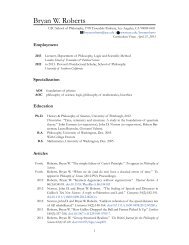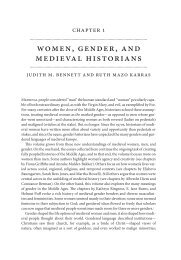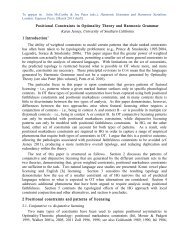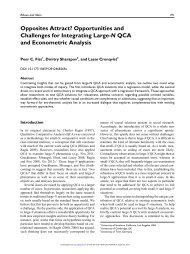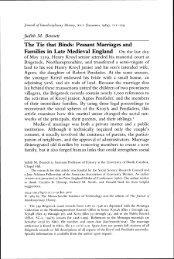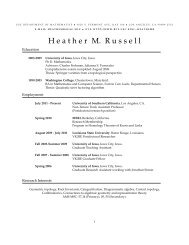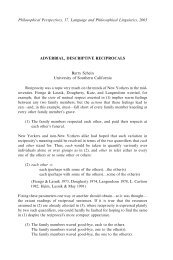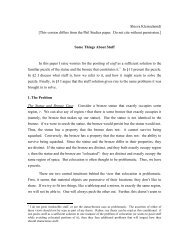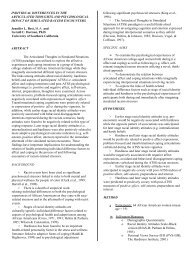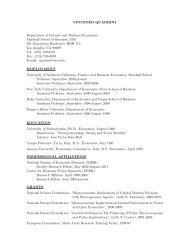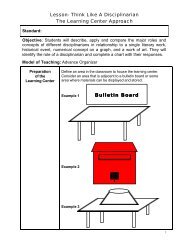The Diffusion of Ideas over Contested Terrain - Personal World Wide ...
The Diffusion of Ideas over Contested Terrain - Personal World Wide ...
The Diffusion of Ideas over Contested Terrain - Personal World Wide ...
Create successful ePaper yourself
Turn your PDF publications into a flip-book with our unique Google optimized e-Paper software.
#2144-ASQ V49 N4-December 2005—file: 49401-fiss<br />
<strong>of</strong> family owners <strong>of</strong>ten do not share the founder’s longer<br />
time horizon and concern for firm survival but are interested<br />
instead in “cashing out” and using the family assets for their<br />
own personal benefit. Kang (1998) has described declining<br />
firm performance and less effective strategic decision making<br />
by later-generation family owners as the “Buddenbrooks<br />
Effect,” drawing on Thomas Mann’s novel <strong>of</strong> that name in<br />
which “the first generation .|.|. builds, the second consolidates,<br />
the third dissipates” (Salin, 1952: 371). <strong>The</strong> idea <strong>of</strong><br />
ascent and decline across three generations <strong>of</strong> family business<br />
(e.g., “clogs to clogs” or “rags to rags”) has been<br />
found across many societies (Ward, 2004), and there are various<br />
explanations. Later generations may be less motivated or<br />
able to run the family business, and larger families in succeeding<br />
generations are <strong>of</strong>ten marked by conflict due to different<br />
interests and values (e.g., Neubauer and Lank, 1998;<br />
Ward, 2004). In those later generations, “the family may be<br />
held together by nothing more than their common financial<br />
interests, and if the returns on their investment are not better<br />
than what they could earn elsewhere, some stockholders<br />
may seek opportunities to sell their shares in the family corporation”<br />
(Gersick et al., 1997: 219). This suggests that a<br />
shareholder value orientation may be quite compatible with<br />
the views <strong>of</strong> third- or later-generation family blockholders. We<br />
suggest a contingent relationship in which later-family owners<br />
support a shareholder value orientation while first and<br />
second generation family owners are less inclined to do so:<br />
Hypothesis 1d (H1d): <strong>The</strong> higher a firm’s ownership by German<br />
families beyond the second generation, the more likely a firm will be<br />
to espouse a shareholder value orientation.<br />
Powerful Managers and <strong>The</strong>ir Preferences<br />
Normative belief structures are not likely to be adopted solely<br />
according to corporate power and control considerations. <strong>The</strong><br />
sociopolitical perspective also highlights the fact that ideas<br />
about the fundamental purpose <strong>of</strong> the corporation and possible<br />
changes in those ideas are likely to have a cognitive<br />
underpinning. This cognitive aspect <strong>of</strong> the possible adoption<br />
<strong>of</strong> a shareholder value orientation may be reflected in the<br />
characteristics <strong>of</strong> top executives, particularly in the demographic<br />
differences that have been shown to influence decision<br />
making and strategic change (e.g., Hambrick and Mason,<br />
1984; Finkelstein and Hambrick, 1990; Wiersema and Bantel,<br />
1992; Belliveau, O’Reilly, and Wade, 1996; Hambrick, Cho,<br />
and Chen, 1996; Jensen and Zajac, 2004). Specifically, educational<br />
background and age may influence the susceptibility <strong>of</strong><br />
corporate elites to a shareholder value orientation.<br />
Educational background <strong>of</strong>ten shapes managers’ mental<br />
models, and a firm’s likelihood <strong>of</strong> adopting a different g<strong>over</strong>nance<br />
model should depend on how this model fits with<br />
managers’ existing mental models. A considerable body <strong>of</strong><br />
research provides support for the important role <strong>of</strong> such<br />
mental models or schemas in influencing how new information<br />
and prior knowledge are integrated (Daft and Weick,<br />
1984; Schwenk, 1988; Barr, Stimpert, and Huff, 1992; Reger<br />
et al., 1994). Furthermore, mental models are usually difficult<br />
to change once they become entrenched (Bartunek, 1984;<br />
510/ASQ, December 2004



